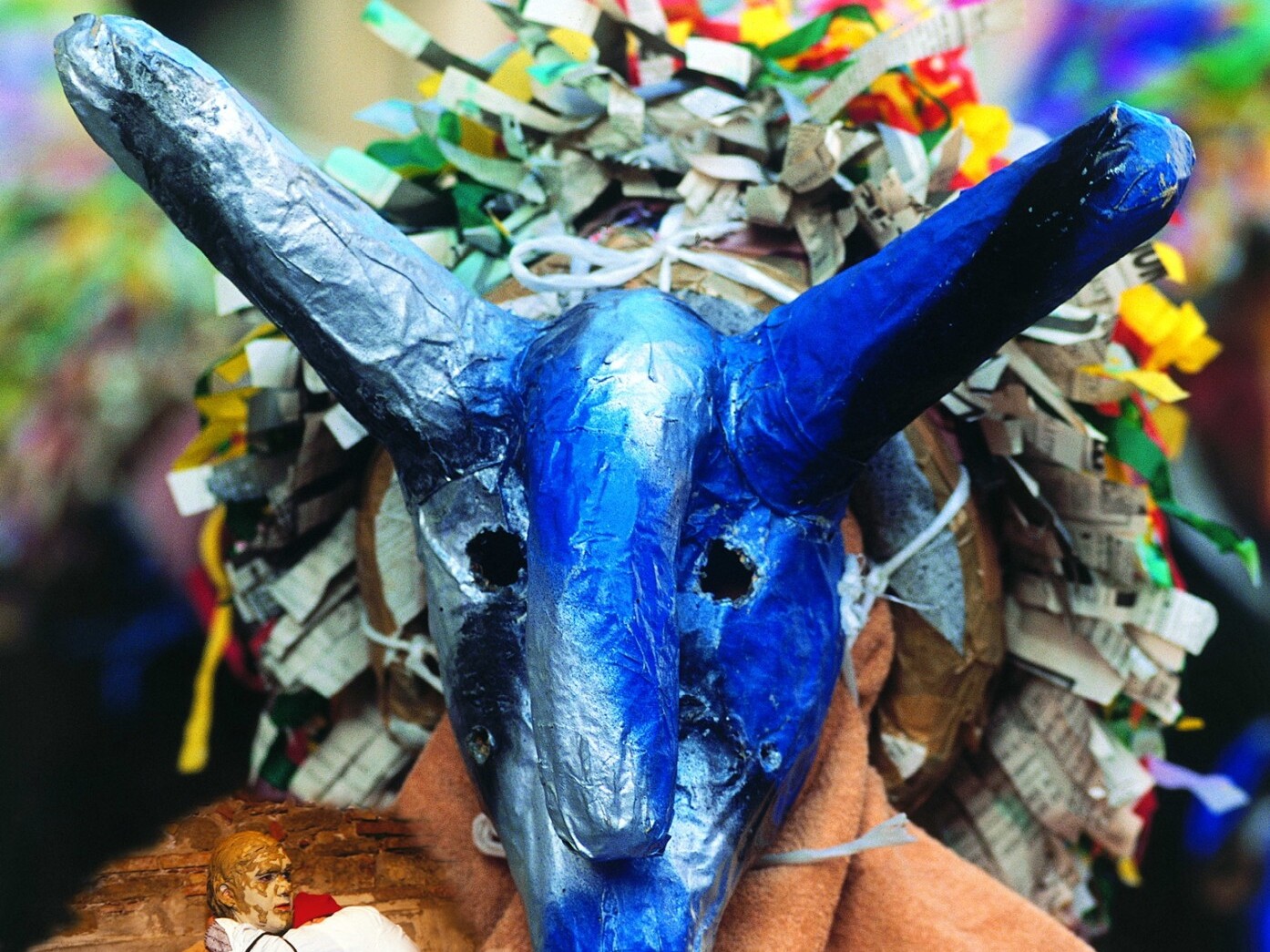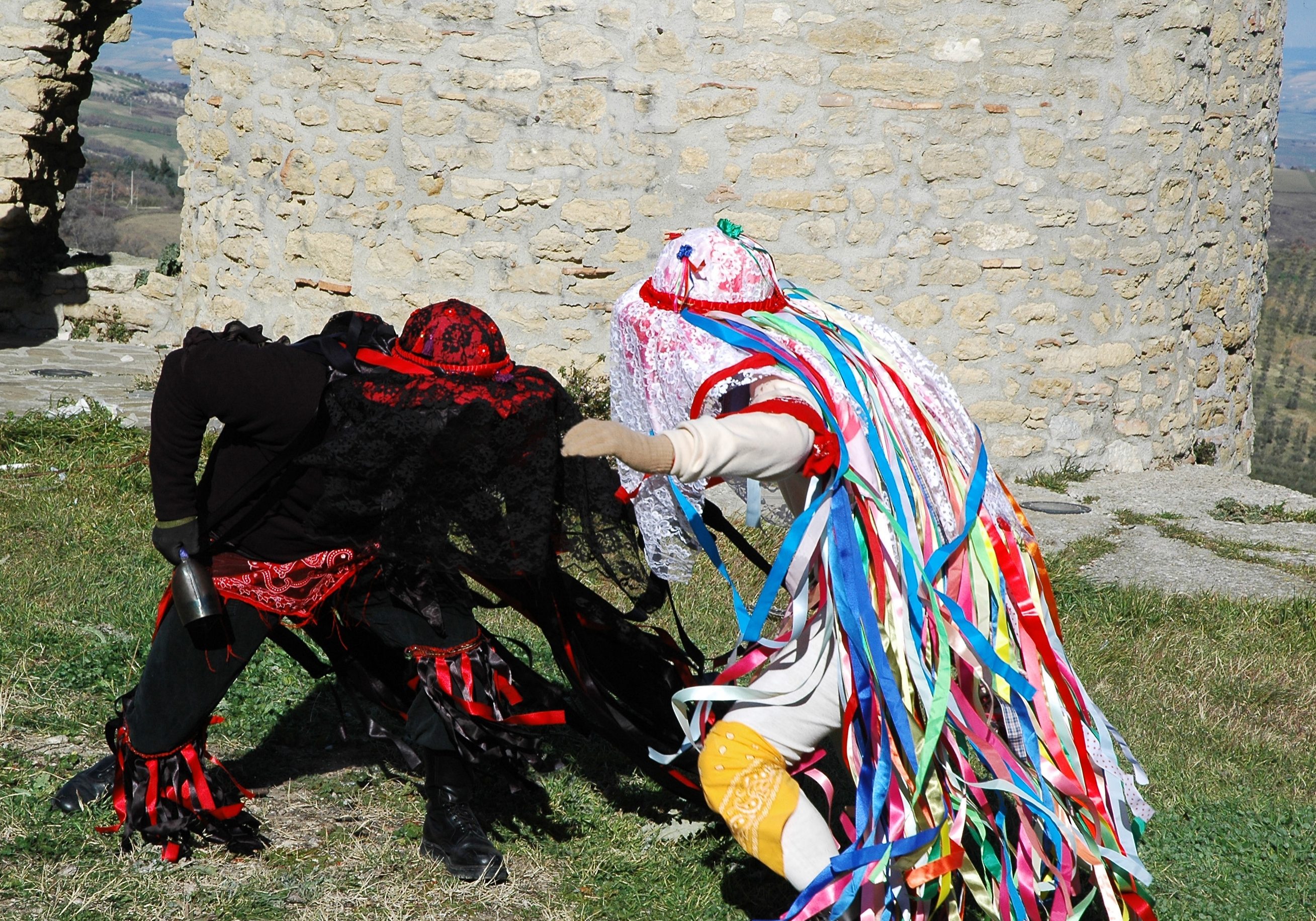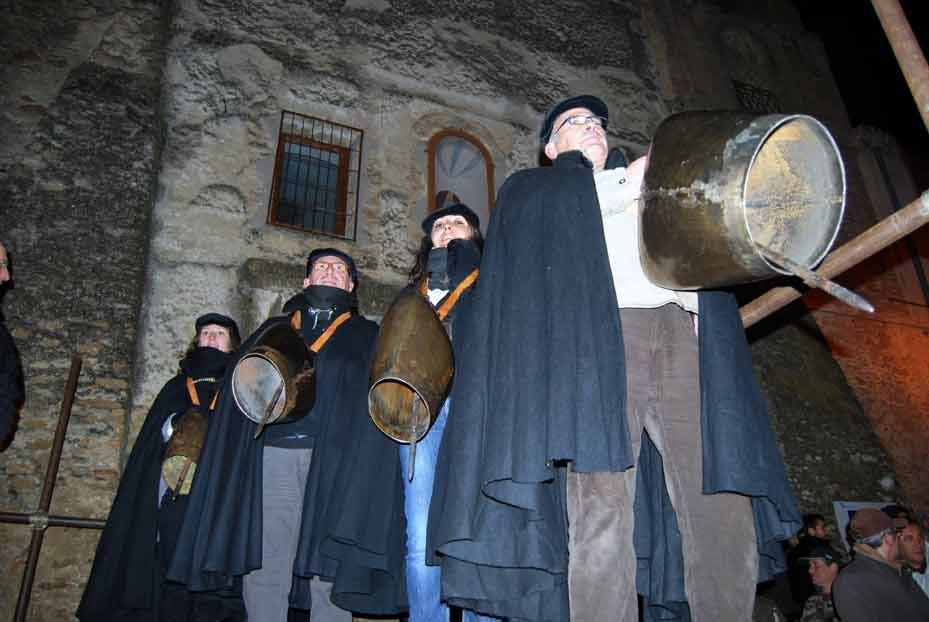"l'Mash-kr", The Masks of Tricarico
Lucanian Carnival

The masks of Tricarico, “l’Mash-kr” in local dialect, epitomise the “bull” and the “cow”.
A wide-brimmed hat covered with a scarf and a veil, both white, decorated with multicoloured ribbons down to the ankles, is the “cow”. A black headdress decorated with long red ribbons is the “Bull”.
The main protagonists of the Tricarico carnival give rein to their cheerfulness on 17th January, on the occasion of Sant’Antonio Abate, and on the Sunday before Shrove Tuesday.
At the crack of dawn a dull and deafening sound wakes the population from their night slumber: it’s the bells, being rung loudly disguised figures announcing the start of the carnival celebrations.
The masks, operated by a “massaro” or “vaccaro” reach the church of Sant’Antonio Abate and from here the tour continues to the old town and the streets of the town, stopping at the historical districts of Rabatana, Saracen and Civita, in a procession that commemorates transhumance, seasonal migration of herds of animals.
Arranged in two rows, according to an ordered pattern, the mimic the gait of the beasts, until the “bulls” rise up, escaping the control of the “boss”, and stage a mating with the “cows”, a legacy of ancestral cultures, linked to fertility rituals.
Comune di Tricarico
T. +39 0835 526111-00
www.comune.tricarico.mt.it
urp.comunetricarico@tiscali.it
Pro Loco di Tricarico
Mob. +39 3273629138
Fb: Il Carnevale e Le Maschere di Tricarico
Fb: Pro Loco di Tricarico
info@lemaschereditricarico.it
prolocotricarico@libero.it
THE MONTESE CARNIVAL AND CARNEVALONE
Lucanian Carnival

The dynamic, colourful displays feature a procession of masked figures and floats created by young, local papier mâché craftsmen, who are custodians of this secular tradition, which move along the city streets.
The Montese Carnevalone and Carnival stand out for the stunning carnival processions and the considerable number of figures who process. The Carnevalone of Montescaglioso has its origins in the peasant world of tenant farmers, shepherds and farm workers.
The costumes are made every year from animal skin, canvas and jute, with plastic bags for the wheat seeds, paper, cardboard and fabric from old clothes. The Carnevalone is a large, elderly gentleman, wrapped in a black cloak with a large hat on his head, who parades through the town, riding a humble donkey, followed by a colourful procession. The distinctive masks and the carriers of the cowbells stand out amongst the group of figures along with Quaremma, the wife of Carnevalone, dressed in black with a newly born child in her arms. The newly born child is Carnevalicchio, who is born when Carnevalone dies on the bonfire.
Infopoint Turistico Abbazia
T./F. +39 0835 201016
Mob.+39 334 8360098
ceamonte@katamail.com
www.cea.mpmtescaglioso.net
The "Horned" Masks Of Aliano
Lucanian Carnival

Every year on Shrove Tuesday, characteristic figures roam the streets of Aliano: they are the “horned” masks that enliven the carnival.
“They were jumping and shouting like maddened beasts,
drunk with their own hue and cry These were peasant masqueraders.
Carlo Levi also mentions “Fras” in his “Christ stopped at Eboli”; an improvised comedy, in dialectal form recounting facts and personages of the local area, whose bizarre horned masks are the protagonists.
They evoke demonic, clumsy creatures, whose threatening character is tempered by colourful hats that decorate their heads.
Forged from clay and papier-mâché, with the skilful work of the local craftsmen, the masks are painted and at the front there are pronounced horns and huge crooked noses. On top of the hats is a hole decorated with a rooster’s feather, while all around strands of coloured paper drop like curls.
The participants parade through the village moving to the sound of accordions and cupa cupa. Unique in their strangeness, the Aliano masks reflect a tradition that has remained unchanged over time.
Parco Letterario CARLO LEVI
T. +39 0835 568529
parcolevi@tiscali.it
Comune di Aliano
T. +39 0835 568038
www.aliano.it
Pro Loco di Aliano
T. +39 0835 568074
“The Festival of the Cowbell” in San Mauro Forte”
Lucanian Carnival

On 16th January the dull but deafening sound of “cowbells” (‘Campanacci’) breaks the quiet of the village in the province of Matera during Carnival, resounding along the streets and alleys, to the Norman Tower, in an atmosphere of captivating mystery.
The ancient rite coincides with the feast of Sant’Antonio Abate, and large groups of men gather here wrapped in cloaks, wearing straw hats and carrying large “male” and “female” cowbells for this symbol of fertility.
Many of the instruments are made by local artisans and, according to popular belief, have apotropaic function and propitiatory properties, to ward off evil and promote good a harvest.
The noises soften when the wanderers stop at the cellars and dining stands set up in the town to enjoy good wine, fresh sausages and other typical products derived from killing the pig – a tradition in San Mauro Forte, and other towns in Basilicata, that is inevitably intertwined with Carnival celebrations.
The Festival comes to an end with the funeral and the lament of the Carnival puppet, which is burned in the town square.
And then, quiet is restored!
Comune di San Mauro Forte
T. +390835674015
F. +390835674288
comunesanmauroforte@rete.basilicata.it
www.comune.sanmauroforte.mt.it
The "Rumit" Tree Man Of The Carnival Of Satriano Di Lucania
Lucanian Carnival

A tree man covered with ivy, the plant that covers the forests of Satriano di Lucania. The “Rumit” is the protagonist of the Carnival, but also a tree ritual of the municipality which falls within the Parco Nazionale dell’appennino Lucano.
The rite sings the praises of nature and its strong ties to man and, on the Saturday before Shrove Tuesday, there is a walking forest, composed of 131 Rumits, representing the number of towns in Basilicata, launching an ecological message and turning one of the town’s squares green. The starting point is the film installation “Alberi” (‘Trees’) by Michelangelo Frammartino, already presented at the MO.MA in New York.
On the morning of the Sunday before Shrove Tuesday, as per tradition, the spontaneous Rumit roam the streets of the town knocking on doors and leaving good wishes in exchange for a gift.
In the afternoon the parade of other typical masks takes place: l’Orso (the bear), la Quaresima (Lent) and the staging of the “marriage” with the exchange of roles.
Comune di Satriano
T. +39 0975 383121 Interno 3
www.comune.satriano.pz.it
comunesatriano@rete.basilicata.it
Associazione AL PARCO
T. +39 329 5320026
Mob. +39 328 6991733
+39 366 8938796
www.alparcolucano.it
carnavaledisatriano@gmail.com
Fb: Carnevale di Satriano
The Bear and The Carnival Of Teana
Lucanian Carnival

Improvisation, instinct, and curiosity characterise the Carnival of Teana, one of the best known and attended in the Basilicata region. The main protagonists are the Bear and the Carnival, and the latter, on the last Saturday, hosts the “trial”, a parody of the “Passion of Christ”.
From the early hours of the morning, a large procession of masks, parades through the woods near the village, where the most distinctive characters meet: the “bride” and “groom” all dressed up, four carabinieri in strict uniform, a priest, a judge and two doctors.
Nobody speaks, so as not to be recognised; the only one to say a word—and it’s always the the same, “sausage”— is “u’ Pezzente”, a beggar who walks supported by a cane, and who collects coins and food in a jute bag.
Then, all dressed in black is the “Quaremma” (Lent), madly in love with Carnevale (Carnival), her husband; a poor peasant already lost in the fumes of alcohol, dragged along, staggering, by two policemen.
Among the masks we can also distinguish the bear, a wild figure with a menacing gait. This strange but lively procession proceeds into the historic centre with dancing and singing in dialect, until we witness the shooting of the “Carnuluvar”.
"The Four Seasons and The Twelve Months of The Year" in Cirigliano
Lucanian Carnival

“.. .but if the comrades are with me, a flask of wine, a piece of sausage, I shoot a woodcock, kill the thrushes, I look at beautiful girls, and live through my memories”.
So reads a passage from the part of “Inverno” (Winter), one of the protagonists of the original carnival of Cirigliano, who wears a robe featuring the characteristics of the reference month or season.
Along the procession, which winds along the roads of the beautiful stone town, the participants, led by a main mask, “Capodanno” (New Year’s Eve), recite poems in a type of Italian that is not really correct, verses handed down from father to son and referring to the abundance of the earth, to spring, and to the collection of specific products.
On the day of Shrove Tuesday, “the months of the year” and “the four seasons” accompany the coffin of Carnival in a procession, dressed to the nines for the occasion, while in the background you hear the eerie wailing of his wife “Quaremma”.
The ironic event culminates with the lighting of the bonfire to burn poor Carnevale who throughout the event is played by a young person from Cirigliano, but in the final phase, of course, is represented by a puppet!
Comune di Cirigliano
T. +39 0835 563081
F. +39 0835 563209
www.comunecirigliano.it
info@comunecirigliano.it
Pro Loco di Cirigliano
T. +39 0835 1853639
Mob. +39 360 438069
www.prolocociricliano.it
prolococirigliano@tiscali.it
The "Domino" in Lavello
Lucanian Carnival

Every Saturday night during the period from 17th January to the Saturday after Ash Wednesday, the Carnival in Lavello is animated by “festini” (parties).
In these attractive locations, staged for the celebrations of the most anticipated period of fun, masked groups gather to dance until morning, while concealing their identity behind the “Domino”, the typical Carnival mask of Lavello.
Besides a long satin tunic, these characters wear a hood and a cape that covers their shoulder and arms. The masks are different colours, and in past times the hue varied depending on the social status of the person who wore them. The most characteristic, now and in the past, is red, which is identified in the colour of the people!
Comune di Lavello
T. +39 0972 80111
F. +39 0972 88643
www.comune.lavello.pz.it
info@comune.lavello.pz.it
Pro Loco “F. Ricciuti” di Lavello
Mob. +39 3333360230;
+39 3281523714;
+39 3394846644
www.prolocolavello.com
prolocofricciuti@libero.it
The Carnival of Straw in Viggianello
Lucanian Carnival

Floats and ‘Pagliarino’, the typical mask, are the protagonists of the “Straw Carnival” of Viggianello.
Willow branches modelled by nimble hands take shape until gigantic structures which are covered with newspaper and paper mache. The parade of floats and masked groups is repeated at two different times, but in both cases the they are highly focused on allegory and folklore.
In Pedali, the new part of Viggianello, everything takes place on the Sunday before Shrove Tuesday, while in the historic centre the parade is held on Shrove Tuesday itself.
The hamlet of Pedali also plays host to the fun trial of the “Straw Carnival”, which ends with the ritual of burning the puppet who is sentenced to death. The traditional Carnival of Viggianello offers spectators unique experiences that blend the beauty of the surrounding landscape with the delicious tastes of the area.
Comune di Viggianello
T. +39 0973 664311
www.comune.viggianello.pz.it
comuneviggianello@libero.it
Pro Loco di Viggianello
prolocoviggianello@gmail.com
www.prolocoviggianello.jimdo.com
www.viggianellovacanze.it
- 1
- 2
Utilizziamo i cookie per garantire il corretto funzionamento del sito web e offrirti una migliore esperienza di navigazione. Cliccando "Accetta" acconsenti di ricevere tutti i cookie del nostro sito; cliccando su "Dettagli" puoi avere maggiori informazioni sui singoli cookie di ogni categoria. Il pulsante "Rifiuta" comporta il permanere delle impostazioni di default, e dunque la continuazione della navigazione con i soli cookie necessari.




















